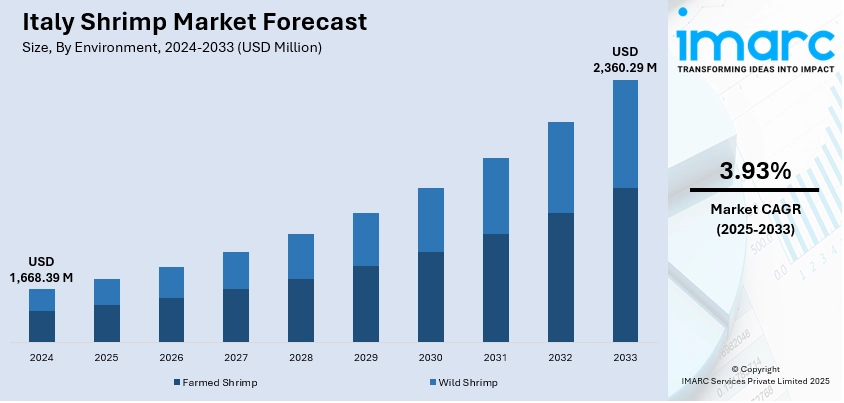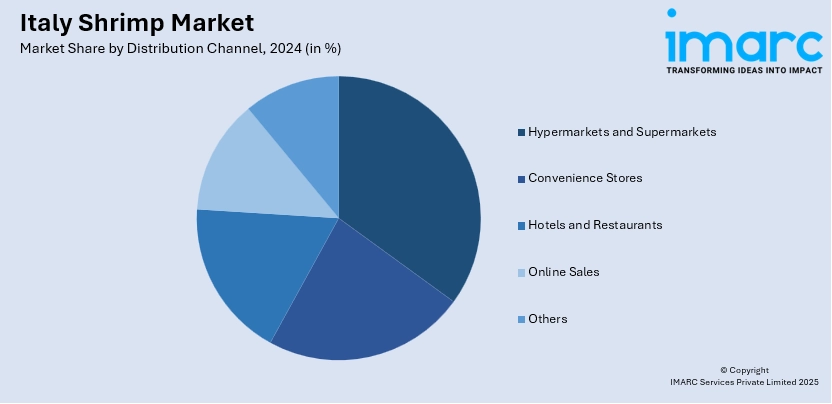
Italy Shrimp Market Size, Share, Trends and Forecast by Environment, Species, Shrimp Size, Distribution Channel, and Region, 2025-2033
Italy Shrimp Market Overview:
The Italy shrimp market size reached USD 1,668.39 Million in 2024. The market is projected to reach USD 2,360.29 Million by 2033, exhibiting a growth rate (CAGR) of 3.93% during 2025-2033. The market is expanding due to increased demand for high-quality, sustainably sourced shrimp. Rising consumer interest in fresh, premium seafood, along with growing imports, is driving market growth. This shift toward ethical sourcing and convenience continues to support Italy shrimp market share.
|
Report Attribute
|
Key Statistics
|
|---|---|
|
Base Year
|
2024
|
|
Forecast Years
|
2025-2033
|
|
Historical Years
|
2019-2024
|
| Market Size in 2024 | USD 1,668.39 Million |
| Market Forecast in 2033 | USD 2,360.29 Million |
| Market Growth Rate 2025-2033 | 3.93% |
Italy Shrimp Market Trends:
Sustainability Fuels Shrimp Demand
Italian shrimp market growth is increasingly driven by growing demand for sustainably sourced seafood. As Italy's consumers become more environmentally aware, there is a discernible trend toward shrimp products that fit sustainability criteria. This trend has urged retailers and restaurants to emphasize the sourcing of shrimp that is eco-friendly certified. To accommodate this increasing trend, numerous shrimp producers are introducing more sustainable forms of farming, such as traceability initiatives and eco-label certifications. These steps guarantee consumers are aware that the shrimp they buy has little or no environmental damage. Additionally, the Italian market enjoys robust regulations that guarantee all imported seafood has high environmental standards. Shrimp farms that operate on systems like recirculating aquaculture systems (RAS) and biofloc are becoming increasingly popular, lowering demand for unnecessary water use and chemicals. With Italian consumers still giving great importance to sustainability, this trend will most probably encourage companies to become even greener in their practice, ensuring a sustainable balance between demand and environmental conservation in the shrimp sector.

To get more information on this market, Request Sample
Shift in Consumer Preferences and Imports
The Italian shrimp industry has experienced great expansion with greater imports and evolving consumer tastes. Premium varieties of shrimp, including headless, shell-on, and peeled ones, are in huge demand among restaurants and high-end retailers and are clear evidence of a premium shift. The high demand for shrimp is mainly fueled by the rising trend in Italy for high-quality, fresh seafood and shrimp becoming an indispensable component of many culinary dishes. Imports from countries such as Ecuador and Southeast Asia meet this demand, offering a varied assortment of shrimp types and sizes for consumer consumption. The increased availability of foreign cuisine, including sushi and tempura, is spreading the popularity of shrimp throughout Italian homes and restaurants. As consumers demand convenience and quality, supermarkets and foodservice operations are responding with an increased variety of products based on shrimp. This trend mirrors the larger patterns in the Italian market; shrimp is no longer a luxury to savor on special occasions alone but a versatile and affordable offer for numerous meals.
Italy Shrimp Market Segmentation:
IMARC Group provides an analysis of the key trends in each segment of the market, along with forecasts at the country and regional level for 2025-2033. Our report has categorized the market based on environment, species, shrimp size, and distribution channel.
Environment Insights:
- Farmed Shrimp
- Wild Shrimp
The report has provided a detailed breakup and analysis of the market based on the environment. This includes farmed shrimp and wild shrimp.
Species Insights:
- Penaeus Vannamei
- Penaeus Monodon
- Macrobrachium Rosenbergii
- Others
The report has provided a detailed breakup and analysis of the market based on the species. This includes penaeus vannamei, penaeus monodon, macrobrachium rosenbergii, and others.
Shrimp Size Insights:
- <21
- 21-25
- 26-30
- 31-40
- 41-50
- 51-60
- 61-70
- >70
The report has provided a detailed breakup and analysis of the market based on the shrimp size. This includes <21, 21-25, 26-30, 31-40, 41-50, 51-60, 61-70, and >70.
Distribution Channel Insights:

- Hypermarkets and Supermarkets
- Convenience Stores
- Hotels and Restaurants
- Online Sales
- Others
A detailed breakup and analysis of the market based on the distribution channel have also been provided in the report. This includes hypermarkets and supermarkets, convenience stores, hotels and restaurants, online sales, and others.
Regional Insights:
- Northwest
- Northeast
- Central
- South
- Others
The report has also provided a comprehensive analysis of all the major regional markets, which include Northwest, Northeast, Central, South, and others.
Competitive Landscape:
The market research report has also provided a comprehensive analysis of the competitive landscape. Competitive analysis such as market structure, key player positioning, top winning strategies, competitive dashboard, and company evaluation quadrant has been covered in the report. Also, detailed profiles of all major companies have been provided.
Italy Shrimp Market Report Coverage:
| Report Features | Details |
|---|---|
| Base Year of the Analysis | 2024 |
| Historical Period | 2019-2024 |
| Forecast Period | 2025-2033 |
| Units | Million USD |
| Scope of the Report |
Exploration of Historical Trends and Market Outlook, Industry Catalysts and Challenges, Segment-Wise Historical and Future Market Assessment:
|
| Environments Covered | Farmed Shrimp, Wild Shrimp |
| Species Covered | Penaeus Vannamei, Penaeus Monodon, Macrobrachium Rosenbergii, Others |
| Shrimp Sizes Covered | <21, 21-25, 26-30, 31-40, 41-50, 51-60, 61-70, >70 |
| Distribution Channels Covered | Hypermarkets and Supermarkets, Convenience Stores, Hotels and Restaurants, Online Sales, Others |
| Regions Covered | Northwest, Northeast, Central, South, Others |
| Customization Scope | 10% Free Customization |
| Post-Sale Analyst Support | 10-12 Weeks |
| Delivery Format | PDF and Excel through Email (We can also provide the editable version of the report in PPT/Word format on special request) |
Key Questions Answered in This Report:
- How has the Italy shrimp market performed so far and how will it perform in the coming years?
- What is the breakup of the Italy shrimp market on the basis of environment?
- What is the breakup of the Italy shrimp market on the basis of species?
- What is the breakup of the Italy shrimp market on the basis of shrimp size?
- What is the breakup of the Italy shrimp market on the basis of distribution channel?
- What is the breakup of the Italy shrimp market on the basis of region?
- What are the various stages in the value chain of the Italy shrimp market?
- What are the key driving factors and challenges in the Italy shrimp market?
- What is the structure of the Italy shrimp market and who are the key players?
- What is the degree of competition in the Italy shrimp market?
Key Benefits for Stakeholders:
- IMARC’s industry report offers a comprehensive quantitative analysis of various market segments, historical and current market trends, market forecasts, and dynamics of the Italy shrimp market from 2019-2033.
- The research report provides the latest information on the market drivers, challenges, and opportunities in the Italy shrimp market.
- Porter's Five Forces analysis assists stakeholders in assessing the impact of new entrants, competitive rivalry, supplier power, buyer power, and the threat of substitution. It helps stakeholders to analyze the level of competition within the Italy shrimp industry and its attractiveness.
- Competitive landscape allows stakeholders to understand their competitive environment and provides an insight into the current positions of key players in the market.
Need more help?
- Speak to our experienced analysts for insights on the current market scenarios.
- Include additional segments and countries to customize the report as per your requirement.
- Gain an unparalleled competitive advantage in your domain by understanding how to utilize the report and positively impacting your operations and revenue.
- For further assistance, please connect with our analysts.
 Request Customization
Request Customization
 Speak to an Analyst
Speak to an Analyst
 Request Brochure
Request Brochure
 Inquire Before Buying
Inquire Before Buying




.webp)




.webp)












